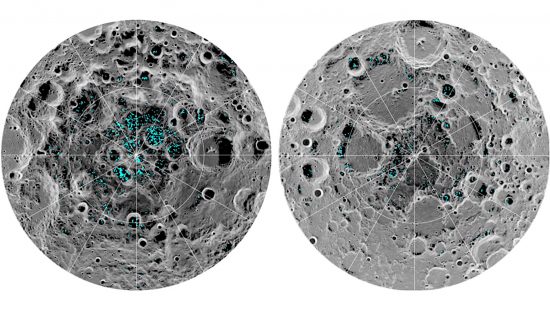
Oct 22, 2019
Ice on the Moon?
“The angel had told me in my dream that if I wanted to acquire the perfect knowledge I desired, I would have to go to the Moon. There I would find Adam’s paradise and the Tree of Knowledge. As soon as I had tasted its fruit, my mind would be enlightened with all the truths a person could know.”
— Cyrano de Bergerac
The Clementine spacecraft entered orbit around the Moon in January 1994. The mission was never completed due to a thruster malfunction, but it was able to map the surface of the Moon. Clementine supposedly discovered water ice in Shackleton crater near the lunar south pole, where there are areas shielded from the Sun.
One caveat, however, is that the Japanese spacecraft Kaguya (launched September 14, 2007) found that the craters contained no ice after all. Its Terrain Camera, with a 10 meter resolution, reported no reflective patches. The small excess of hydrogen ions recorded by Clementine’s instruments was thought to be implanted in the lunar regolith by the solar wind, which is mostly protons.
Recently, scientists from the University of Hawaii, Brown University and the NASA Ames Research Center announced that data from the Moon Mineralogy Mapper (M3) onboard the Chandrayaan-1 spacecraft, launched in 2008, indicates solid ice on the Moon. Again, the data seems to show that there is water in southern lunar craters, as well as in northern shaded regions.
NASA’s goals include a manned lunar base. Cost and scaling problems do not allow such a mission at this time, because life support for even a small group of astronauts, along with power and fuel for the space vehicle, would be impossible to carry. Food and water supplies, not to mention a habitat capable of an extended stay on the Moon, are beyond our current technology. Launching the payloads means a project too costly to contemplate, even if it were technically feasible.
Water ice can be split into oxygen and hydrogen, so solar panels could create breathable air, potable water, and hydrazine fuel. Since areas of the south pole not far from some of the permanently shadowed craters are mountainous regions known as “peaks of eternal sunshine”, there is a continuous energy source available.
Lunar regolith contains many different compounds that can combine into useful chemicals. With a power source and water, the scaling and cost problems diminish, because no fuel except that required to reach the Moon need be sent. A smaller fuel tank means a larger crew and more science experiments, as well.
However, Clementine’s data was questioned and a later impactor called, LCROSS, was unable to determine if ice exists on the Moon. Reflections off the steep crater walls might be the source for all three observations and not ice deposits. Will this new information also fall victim to better detectors and analysis algorithms?
Stephen Smith
The Thunderbolts Picture of the Day is generously supported by the Mainwaring Archive Foundation.












